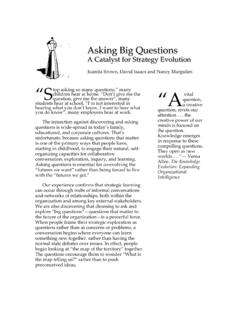Transcription of Evolving Talent Acquisition Trends
1 5 Key Talent Acquisition Strategies for a New Decade Best Practices for Effective Talent Acquisition during a New Era in Talent Management An iCIMS White Paper In many ways the coming decade will redefine the Talent management space. Coming out of the worst recession since WWI, Talent management is on the rebound and organizations must ensure they have the Talent Acquisition processes in place to flourish during a time of increased growth. Looking ahead, organizations need to take a step back and evaluate their Talent Acquisition processes. Does your organization have the technologies in place to attract, engage and retain the most qualified workers?
2 Is your organization prepared for a retirement surge when the baby boomers leave the workforce at an astounding rate? These are only two of the many questions Talent management professionals should be asking themselves as they prepare for the new decade, and in many ways, a new era in Talent management. Below are Five Key Talent Acquisition Strategies your organization should incorporate into your Talent Management program throughout the new decade: 1. Social Media The latter part of this past decade is proof of the unyielding power social media networks have on Talent management. Since inception in a Harvard dorm room only 6 years ago, Facebook has grown to more than 400 million users worldwide.
3 To put this figure in perspective, that s more than the population of the United States and Canada combined! Even more remarkable, the fastest growing age bracket of active Facebook users is 35 49 year olds, highly contributing members of the workforce1. Add Twitter, LinkedIn, Ning and the countless other social networks, and you have a powerful Talent Acquisition tool. 1 BNET Basics, Where Your Customers Are: How Facebook, Twitter and Others Breakdown by Age. The Figures: Facebook has grown to more than 400 million users in 6 years. Throughout the coming decade, social networks will continue to be the best way to form relationships with both passive and active candidates.
4 Instead of the one-time static relationships candidates might have expected from recruiters, social networks will allow recruiters to have long term dynamic relationships with an extensive Talent pipeline. With passive candidates making up more that 70% of the workforce, leveraging these relationships through social networks is more important than ever2. Social networks also directly affect your employment brand and a candidate s perception of your job opportunities. By formally incorporating social networks into their Talent management strategies, organizations can take ownership of how their employment brand is portrayed3. Furthermore, forward thinking organizations are now leveraging social media outlets to strengthen and promote their employee referral programs programs often cited as the most cost effective source of qualified Talent .
5 Long viewed as the most effective way to attract and identify top hires, social media programs that leverage employee referrals decrease turnover, reduce cost per hire and improve new hire time-to-productivity4. Contrary to original predictions, social media is not a fad. More and more organizations are discovering the remarkable value proposition social media holds. With Talent Management Solutions integrating with social networks, it is easier than ever to launch, measure and capture data from candidates and employees through social networks5. 2. Corporate Responsibility & Going Green What was once a buzz word will now play a critical role in Talent management.
6 In addition to realizing substantial cost savings, organizations that build sustainability into their daily operations improve their image in the marketplace for customers, current employees and future applicants. More and more people want to work for companies that make a difference in the environment and community. Competitive organizations should recommit to becoming green and promoting corporate citizenship throughout the community as well within their given industry. According to the 2009 Green Workplace Study conducted by the Society of Human Resources Management, 20% of HR Professionals work at companies that have formal, environmentally friendly policies.
7 This percent is expected to sky rocket in 2010 as 2 Doug Berg, Social Recruiting: What s Your Strategy?, Recruiting Trends , (2009) 3 Josh Bersin, Enterprise Learning and Talent Management Predictions 2010, Bersin & Associates Research Report (December 2009) 4 Madeline Laurano, The Power of Referrals: Next Generation Recruitment, (March 12, 2009) 5 Josh Bersin, Enterprise Learning and Talent Management Predictions 2010, Bersin & Associates Research Report (December 2009) Best Practices: Social networks allow recruiters to maintain long term dynamic relationships with an extensive pipeline of passive candidates. The Figures: 20% of HR Professionals work at companies with formal green policies.
8 More and more organizations seek to gain a competitive advantage by becoming the GREEN leader in their given industry6. Did you know that an average pine tree yields 80,000 sheets of paper? That may sound like a lot of paper but consider this statistic: an organization that hires 500 new employees a year wastes more than 80,000 sheets of paper on offer packages alone. Now factor in employee handbooks, stock option information, employee surveys, benefits enrollment, performance assessments and all of the other critical documents that HR distributes on an annual basis. An HR department s dependence on paper based processes often translates into killing numerous trees each year.
9 Automating your organization s HR processes, such as recruiting, onboarding and performance management programs, is the first step towards going green. And, thanks to the wide spread success of Software-as-a-service HR solutions, it is easier than ever for HR departments to GO GREEN. Web-based models allow users to access the platform from anywhere in the world, including their home office. Furthermore, unique iForm technology eliminates the reliance on paper processes throughout the Talent lifecycle. Going green and giving back can mean something different to every organization. Common green workplace initiatives outside of automating HR processes include Web conferencing, reduced paper use, direct deposit, mass transit programs and recycling, however that is just the beginning.
10 An increasing number of organizations are taking their corporate green initiatives a step further. Organizations are purchasing Green-e Certified Renewable Energy Certificates (RECs) to match their annual energy usage and balance out their corporate carbon footprints. Furthermore, many organizations are opting to work in LEED certified work spaces. LEED is an internationally recognized green building certification system, providing third-party verification that a building was designed using strategies aimed at improving performance across the following metrics: energy savings, water efficiency, CO2 emissions reduction, improved indoor environmental quality, and stewardship of resources and sensitivity to their impacts.







